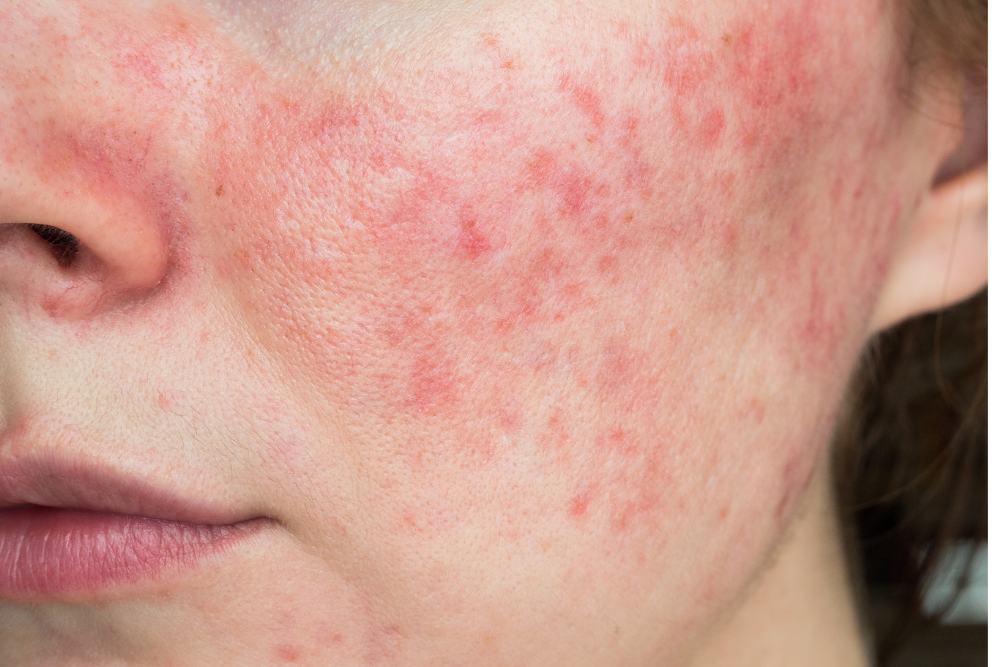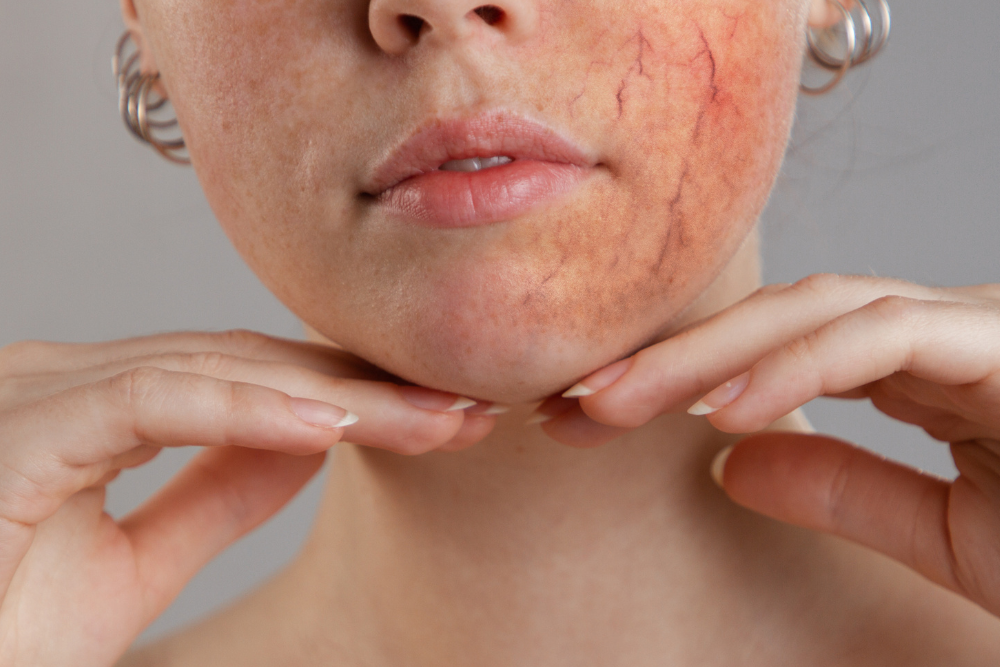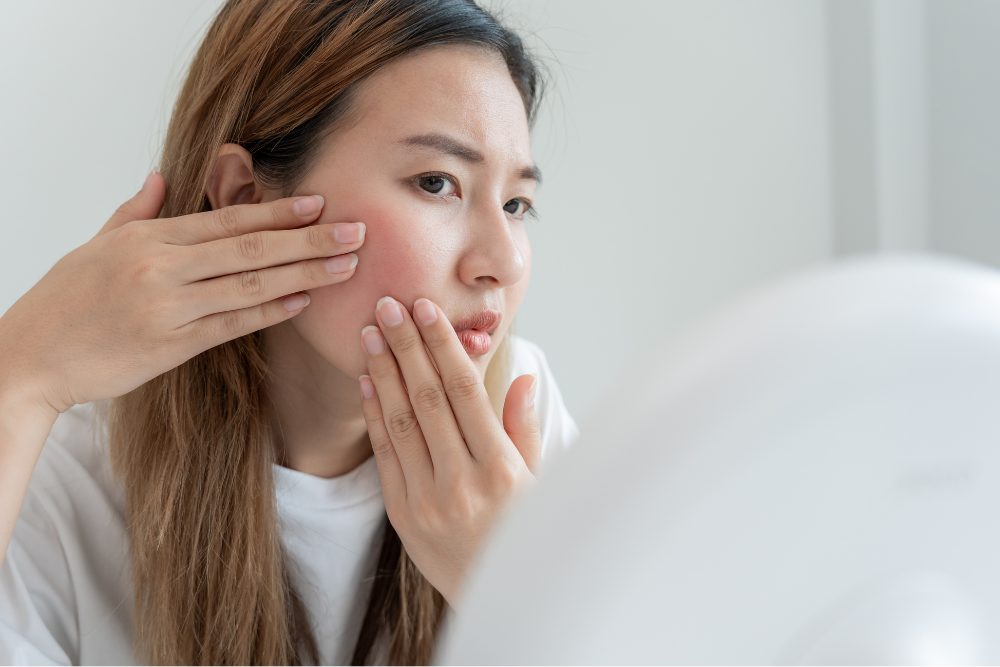The exact cause of rosacea is unknown, but it is believed to result from a combination of genetic and environmental factors that lead to abnormalities in facial blood vessels and immune response. Triggers such as sun exposure, stress, spicy foods, and alcohol can exacerbate the condition (1).
Have you ever noticed persistent redness or pus-filled bumps that resemble acne on your face? It could be symptoms of rosacea, a common skin condition that’s more than just a surface problem. It’s like a puzzle—made up of genetics, lifestyle, and environmental triggers—that researchers are still piecing together. Whether it’s mild, modertate or severe rosacea, it’s clear that there’s a lot going on behind the scenes, from inflammation to broken blood vessels. So, let’s uncover the causes of rosacea.
What Causes Rosacea?
Rosacea manifests in various types, each presenting distinct symptoms. Although the precise cause of rosacea remains unknown, several factors are thought to contribute to its development: genetics, environmental triggers and a reaction to the demodex mite (1).
Genetics
There appears to be a genetic component to rosacea, as it often runs in families. Certain genetic predispositions may make some individuals more susceptible to developing the condition.
Environmental Triggers
Various environmental factors can trigger or exacerbate rosacea symptoms. These triggers may include sun exposure, extreme temperatures (hot or cold), wind, humidity, and consumption of spicy foods or alcohol.
Demodex Mites
Demodex folliculorum and Demodex brevis are microscopic mites that inhabit the hair follicles of the skin. While these mites are present on most people’s skin, individuals with rosacea may have higher populations of these mites or may have an abnormal immune response to their presence, leading to inflammation and the development of rosacea symptoms.
Overall, the development of rosacea is likely multifactorial, involving a combination of genetic predisposition, environmental triggers such as sun exposure, spicy foods, immune system dysfunction, and potentially microorganisms like Demodex mites. Understanding these factors can help in getting rosacea treated effectively.

Common Triggers
Rosacea, a common skin condition characterised by facial redness, inflammation, and sometimes acne-like bumps, can be exacerbated by various triggers. Understanding these triggers is essential for managing rosacea symptoms effectively. Here are some common rosacea triggers:
Sun exposure
UV rays can aggravate rosacea symptoms, leading to increased redness and inflammation. Protecting the skin with sunscreen and seeking shade when outdoors is important.
Spicy foods and hot beverages
Consuming spicy foods or hot drinks can cause flushing and irritation in those with rosacea, making symptoms more noticeable.
Alcohol consumption
Alcohol, particularly red wine and other forms of alcohol with high histamine content, is known to trigger rosacea flare-ups in many people.
Stress
Emotional stress can have a significant impact on symptoms of rosacea, often leading to increased redness and heightened sensitivity in affected individuals.
Harsh skincare products
Certain skincare products containing fragrances, alcohol, or other irritants can worsen rosacea symptoms, leading to increased redness, inflammation, and discomfort.
Symptoms and Signs of Rosacea
Rosacea manifests through various symptoms and signs, which can vary in intensity and presentation from person to person. Understanding these manifestations is essential for early detection and effective management. Here are some common symptoms and signs:
Facial redness
Persistent redness, often on central facial skin, is a hallmark symptom of rosacea. This facial redness may come and go, but it tends to worsen over time.
Flushing
People with rosacea may experience episodes of sudden and intense flushing, causing the face to become red and warm.
Visible blood vessels
Small, visible blood vessels (telangiectasia) may appear on the cheeks, nose, forehead, and chin, contributing to the skin’s overall redness and vascular appearance.
Papules and pustules
Inflammatory lesions resembling acne may develop, particularly in the central facial area. These papules and pustules are often tender and may be mistaken for acne vulgaris.
Thickened skin
In some cases, severe symptoms of rosacea can thicken the skin, especially around the nose (rhinophyma). This condition is more common in men and may cause the nose to appear bulbous and swollen.
By recognising these symptoms and signs, individuals affected by rosacea can seek appropriate rosacea treatment and management strategies to alleviate discomfort and prevent the worsening of the condition. Treating rosacea early can also help reduce the risk of complications and improve overall quality of life.

How is Rosacea Treated?
Although there’s no cure for rosacea, various treatments can help manage the symptoms. Your doctor or dermatologist might recommend several options.
To start, you can take some general steps to ease your symptoms:
- Avoid known triggers.
- Use non-irritating, oil-free (non-comedogenic) skincare products.
- Apply sunscreen and wear a hat when outdoors.
- Keep your face cool to reduce flushing.
- Avoid using corticosteroid creams or ointments on your face, as they can worsen rosacea.
Specific treatments include both topical applications (applied to the skin) and oral medications (taken as tablets) to help manage symptoms. Topical treatments can reduce redness and inflammation, while oral medications may be prescribed for more severe cases (1).
Laser treatment might be recommended to address visible blood vessels or redness, requiring multiple sessions. Since rosacea can recur, you may need additional treatments over time.
For eye symptoms, it’s advisable to consult an ophthalmologist (1).
By incorporating these treatments and lifestyle changes into a comprehensive management plan, people with rosacea can effectively control their symptoms and improve their skin’s appearance and overall quality of life.
Lifestyle changes
Lifestyle changes can play a significant role in managing rosacea and reducing the frequency and severity of flare-ups. Here are some lifestyle changes to consider:
Stay cool
Heat can exacerbate rosacea symptoms, so try to stay cool whenever possible. Use fans or air conditioning to regulate indoor temperatures, and avoid hot baths, saunas, and steam rooms.
Maintain a healthy diet
While there’s no specific rosacea diet, some individuals find that certain foods or drinks can trigger flare-ups. Keep a food diary to identify potential triggers and consider limiting or avoiding them.
Stay hydrated
Drink plenty of water to keep your skin hydrated and healthy. Avoid excessive caffeine and alcohol consumption, as these can dehydrate the skin and exacerbate symptoms of rosacea.
By including these lifestyle changes into your daily routine, you can effectively manage your rosacea and improve the overall health and appearance of your skin. Finding what works best for you may take some trial and error, so be patient and consistent in your efforts.

Seeking professional help
Professional help is essential for dealing with rosacea, especially if home remedies haven’t worked. Hub.health providers specialise in treating skin conditions like rosacea and can create personalised plans to ease symptoms and prevent flare-ups. They’ll assess the severity of your rosacea and suggest treatment options. Plus, they can advise on skin care routines, lifestyle changes, and avoiding triggers.
Ready to treat rosacea? Start your consultation today!
Source:
- Victoria State Government. Rosacea [Internet]. Victoria: Better Health Channel; 2022 [cited 2024 Jul 5]. Available from: https://www.betterhealth.vic.gov.au/health/conditionsandtreatments/rosacea





